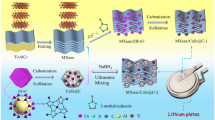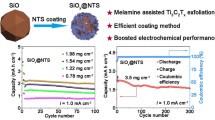Abstract
Ti3C2 MXene, a new family of two-dimensional (2D) materials with metallic conductivity and excellent electrochemical stability, is one of the most promising materials for energy storage. However, its limited interlayer distance and low capacity still impede its further application in Li+ batteries. To address this problem, a facile wet chemical method is developed to construct β-FeOOH/Ti3C2 composites assisted by the alkalization treatment of Ti3C2. The structural and electrochemical properties of β-FeOOH/Ti3C2 are influenced by alkalization treatment and Fe3+ content. The alkalized Ti3C2 offers larger structural pathway for easy lithium ion transport and buffers the volume changes of FeOOH during lithiation/delithiation. As a result, the β-FeOOH/Ti3C2 composite anodes exhibit good rate performance with a capacity of 332 mAh g−1 at 0.5 A g−1 and an improved cycling capacity 432 mAh g−1 at 0.2 A g−1 after 400 cycles. This study is expected to stimulate the intensive research and development on the MXene-based materials for lithium-ion batteries.







Similar content being viewed by others
References
Thackeray MM, Wolverton C, Isaacs ED (2012) Electrical energy storage for transportation—approaching the limits of, and going beyond, lithium-ion batteries. Energy Environ Sci 5:7854–7863
Dunn B, Kamath H, Tarascon JM (2011) Electrical energy storage for the grid: a battery of choices. Science 334:928–935
Karden E, Ploumen S, Fricke B, Miller T, Snyder K (2007) Energy storage devices for future hybrid electric vehicles. J Power Sources 168:2–11
Liu YT, Zhang P, Sun N, Anasori B, Zhu QZ, Liu H, Gogotsi Y, Xu B (2018) Self-assembly of transition metal oxide nanostructures on MXene nanosheets for fast and stable lithium storage. Adv Mater 30:1707334
Poizot P, Laruelle S, Grugeon S, Dupont L, Tarascon JM (2000) Nano-sized transition-metal oxides as negative-electrode materials for lithium-ion batteries. Nature 407:496–499
Wang J, Yang N, Tang H, Dong Z, Jin Q, Yang M, Kisailus D, Zhao H, Tang Z, Wang D (2013) Accurate control of multishelled Co3O4 hollow microspheres as high-performance anode materials in lithium-ion batteries. Angew Chem 125:6545–6548
Reddy ALM, Shaijumon MM, Gowda SR, Ajayan PM (2009) Coaxial MnO2/carbon nanotube array electrodes for high-performance lithium batteries. Nano Lett 9:1002–1006
Zhou X, Wan LJ, Guo YG (2013) Binding SnO2 nanocrystals in nitrogen-doped graphene sheets as anode materials for lithium-ion batteries. Adv Mater 25:2152–2157
Chen Z, Gao Y, Zhang Q, Li L, Ma P, Xing B, Zhang Z (2019) TiO2/NiO/reduced graphene oxide nanocomposites as anode materials for high-performance lithium ion batteries. J Alloys Compd 774:873–878
Wang X, Chen X, Gao L, Zheng H, Ji M, Tang C, Shen T, Zhang Z (2004) Synthesis of β-FeOOH and α-Fe2O3 nanorods and electrochemical properties of β-FeOOH. J Mater Chem 14:905–907
Flynn CM Jr (1984) Hydrolysis of inorganic iron (III) salts. Chem Rev 84:31–41
Amine K, Yasuda H, Yamachi M (1999) β-FeOOH, a new positive electrode material for lithium secondary batteries. J Power Sources 81:221–223
Yu L, Xi S, Wei C, Zhang W, Du Y, Yan Q, Xu Z (2015) Superior lithium storage properties of β-FeOOH. Adv Energy Mater 5:1401517
Sun Y, Hu X, Luo W, Xu H, Hu C, Huang Y (2013) Synthesis of amorphous FeOOH/reduced graphene oxide composite by infrared irradiation and its superior lithium storage performance. ACS Appl Mater Interfaces 5:10145–10150
Imtiaz M, Chen Z, Zhu C, Pan H, Zada I, Li Y, Zhu S (2018) In situ growth of β-FeOOH on hierarchically porous carbon as anodes for high-performance lithium-ion batteries. Electrochim Acta 283:401–409
Zhang E, Wang B, Yu X, Zhu J, Wang L, Lu B (2017) β-FeOOH on carbon nanotubes as a cathode material for Na-ion batteries. Energy Storage Mater 8:147–152
Zhang M, Han D, Lu P (2017) PEDOT encapsulated β-FeOOH nanorods: synthesis, characterization and application for sodium-ion batteries. Electrochim Acta 238:330–336
Naguib M, Kurtoglu M, Presser V, Lu J, Niu J, Heon M, Barsoum MW (2011) Two-dimensional nanocrystals produced by exfoliation of Ti3AlC2. Adv Mater 23:4248–4253
Lei JC, Zhang X, Zhou Z (2015) Recent advances in MXene: preparation, properties, and applications. Front Phys 10:276–286
Er D, Li J, Naguib M, Gogotsi Y, Shenoy VB (2014) Ti3C2 MXene as a high capacity electrode material for metal (Li, Na, K, Ca) ion batteries. ACS Appl Mater Interfaces 6:11173–11179
Zhao MQ, Ren CE, Ling Z, Lukatskaya MR, Zhang C, Van Aken KL, Gogotsi Y (2015) Flexible MXene/carbon nanotube composite paper with high volumetric capacitance. Adv Mater 27:339–345
Naguib M, Come J, Dyatki B, Presser V, Taberna PL, Simon P, Gogotsi Y (2012) MXene: a promising transition metal carbide anode for lithium-ion batteries. Electrochem Commun 16:61–64
Xiong D, Li X, Bai Z, Lu S (2018) Recent advances in layered Ti3C2Tx MXene for electrochemical energy storage. Small 14:1703419
Hu M, Hu T, Li Z, Yang Y, Cheng R, Yang J, Wang X (2018) Surface functional groups and interlayer water determine the electrochemical capacitance of Ti3C2Tx MXene. ACS Nano 12:3578–3586
Hu T, Li Z, Hu M, Wang J, Hu Q, Li Q, Wang X (2017) Chemical origin of termination-functionalized MXenes: Ti3C2T2 as a case study. J Phys Chem C 121:19254–19261
Ding L, Wei Y, Wang Y, Chen H, Caro J, Wang H (2017) A two-dimensional lamellar membrane: MXene nanosheet stacks. Angew Chem Int Ed 56:1825–1829
Cheng R, Hu T, Zhang H, Wang C, Hu M, Yang J, Hou P (2018) Understanding the lithium storage mechanism of Ti3C2Tx MXene. J Phys Chem C 123:1099-1109
Tang Q, Zhou Z, Shen P (2012) Are MXenes promising anode materials for Li ion batteries? Computational studies on electronic properties and Li storage capability of Ti3C2 and Ti3C2X2 (X = F, OH) monolayer. J Am Chem Soc 134:16909–16916
Lian P, Dong Y, Wu ZS, Zheng S, Wang X, Wang S, Bao X (2017) Alkalized Ti3C2 MXene nanoribbons with expanded interlayer spacing for high-capacity sodium and potassium ion batteries. Nano Energy 40:1–8
Bao W, Liu L, Wang C, Choi S, Wang D, Wang G (2018) Facile synthesis of crumpled nitrogen-doped MXene nanosheets as a new sulfur host for lithium-sulfur batteries. Adv Energy Mater 8:1702485
Ma Z, Zhou X, Deng W, Lei D, Liu Z (2018) 3D porous MXene (Ti3C2)/reduced graphene oxide hybrid films for advanced lithium storage. ACS Appl Mater Interfaces 10:3634–3643
Xie X, Kretschmer K, Anasori B, Sun B, Wang G, Gogotsi Y (2018) Porous Ti3C2Tx MXene for ultrahigh-rate sodium-ion storage with long cycle life. ACS Appl Nano Mater 1:505–511
Ren CE, Zhao MQ, Makaryan T, Halim J, Boota M, Kota S, Gogotsi Y (2016) Porous two-dimensional transition metal carbide (MXene) flakes for high-performance Li-ion storage. ChemElectroChem 3:689–693
Liu J, Zheng M, Shi X, Zeng H, Xia H (2016) Amorphous FeOOH quantum dots assembled mesoporous film anchored on graphene nanosheets with superior electrochemical performance for supercapacitors. Adv Funct Mater 26:919–930
Guo X, Xie X, Choi S, Zhao Y, Liu H, Wang C, Wang G (2017) Sb2O3/MXene (Ti3C2Tx) hybrid anode materials with enhanced performance for sodium-ion batteries. J Mater Chem A 5:12445–12452
Ma K, Jiang H, Hu Y, Li C (2018) 2D Nanospace confined synthesis of pseudocapacitance-dominated MoS2-in-Ti3C2 superstructure for ultrafast and stable Li/Na-ion batteries. Adv Funct Mater 28:1804306
Simon P (2017) Two-dimensional MXene with controlled interlayer spacing for electrochemical energy storage. ACS Nano 11:2393–2396
Luo J, Zhang W, Yuan H, Jin C, Zhang L, Huang H, Tao X (2017) Pillared structure design of MXene with ultralarge interlayer spacing for high-performance lithium-ion capacitors. ACS Nano 11:2459–2469
Lukatskaya MR, Mashtalir O, Ren CE, Dall’Agnese Y, Rozier P, Taberna PL, Gogotsi Y (2013) Cation intercalation and high volumetric capacitance of two-dimensional titanium carbide. Science 341:1502–1505
Luo J, Tao X, Zhang J, Xia Y, Huang H, Zhang L, Zhang W (2016) Sn4+ ion decorated highly conductive Ti3C2 MXene: promising lithium-ion anodes with enhanced volumetric capacity and cyclic performance. ACS Nano 10:2491–2499
Peng Q, Guo J, Zhang Q, Xiang J, Liu B, Zhou A, Tian Y (2014) Unique lead adsorption behavior of activated hydroxyl group in two-dimensional titanium carbide. J Am Chem Soc 136:4113–4116
Luo J, Fang C, Jin C, Yuan H, Sheng O, Fang R, Liang C (2018) Tunable pseudocapacitance storage of MXene by cation pillaring for high performance sodium-ion capacitors. J Mater Chem A 6:7794–7806
Luo J, Wang C, Wang H, Hu X, Matios E, Lu X, Li W (2019) Pillared MXene with ultralarge interlayer spacing as a stable matrix for high performance sodium metal anodes. Adv Funct Mater 29:1805946
Shah SA, Habib T, Gao H, Gao P, Sun W, Green MJ, Radovic M (2017) Template-free 3D titanium carbide (Ti3C2Tx) MXene particles crumpled by capillary forces. Chem Commun 53:400–403
Li N, Wei S, Xu Y, Liu J, Wu J, Jia G, Cui X (2018) Synergetic enhancement of oxygen evolution reaction by Ti3C2Tx nanosheets supported amorphous FeOOH quantum dots. Electrochim Acta 290:364–368
Peng S, Yu L, Sun M, Cheng G, Lin T, Mo Y, Li Z (2015) Bunched akaganeite nanorod arrays: preparation and high-performance for flexible lithium-ion batteries. J Power Sources 296:237–244
Qi H, Cao L, Li J, Huang J, Xu Z, Cheng Y, Yanagisawa K (2016) High pseudocapacitance in FeOOH/rGO composites with superior performance for high rate anode in Li-ion battery. ACS Appl Mater Interfaces 8:35253–35263
Ahmed B, Anjum DH, Gogotsi Y, Alshareef HN (2017) Atomic layer deposition of SnO2 on MXene for Li-ion battery anodes. Nano Energy 34:249–256
Sun H, Xin G, Hu T, Yu M, Shao D, Sun X, Lian J (2014) High-rate lithiation-induced reactivation of mesoporous hollow spheres for long-lived lithium-ion batteries. Nat Commun 5:4526
Zhu K, Zhang Y, Qiu H, Meng Y, Gao Y, Meng X, Wei Y (2016) Hierarchical Fe3O4 microsphere/reduced graphene oxide composites as a capable anode for lithium-ion batteries with remarkable cycling performance. J Alloys Compd 675:399–406
Funding
This work was supported by National Key R&D Program of China (2016YFE0131200), the National Natural Science Foundation of China (51702098), International Cooperation Project of Shanghai Municipal Science and Technology Committee (18520744400), and Research Program supported by the Ministry of Education, Youth, and Sports of the Czech Republic (LTACH17015).
Author information
Authors and Affiliations
Corresponding authors
Additional information
Publisher’s note
Springer Nature remains neutral with regard to jurisdictional claims in published maps and institutional affiliations.
Rights and permissions
About this article
Cite this article
Xue, C., He, Y., Liu, Y. et al. Controlled synthesis of alkalized Ti3C2 MXene-supported β-FeOOH nanoparticles as anodes for lithium-ion batteries. Ionics 25, 3069–3077 (2019). https://doi.org/10.1007/s11581-019-02901-0
Received:
Revised:
Accepted:
Published:
Issue Date:
DOI: https://doi.org/10.1007/s11581-019-02901-0




